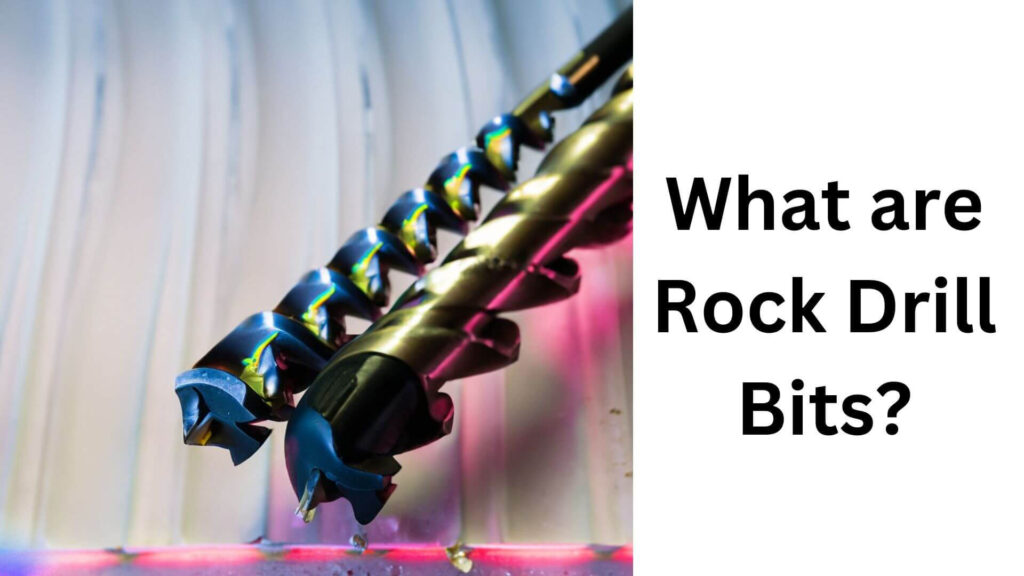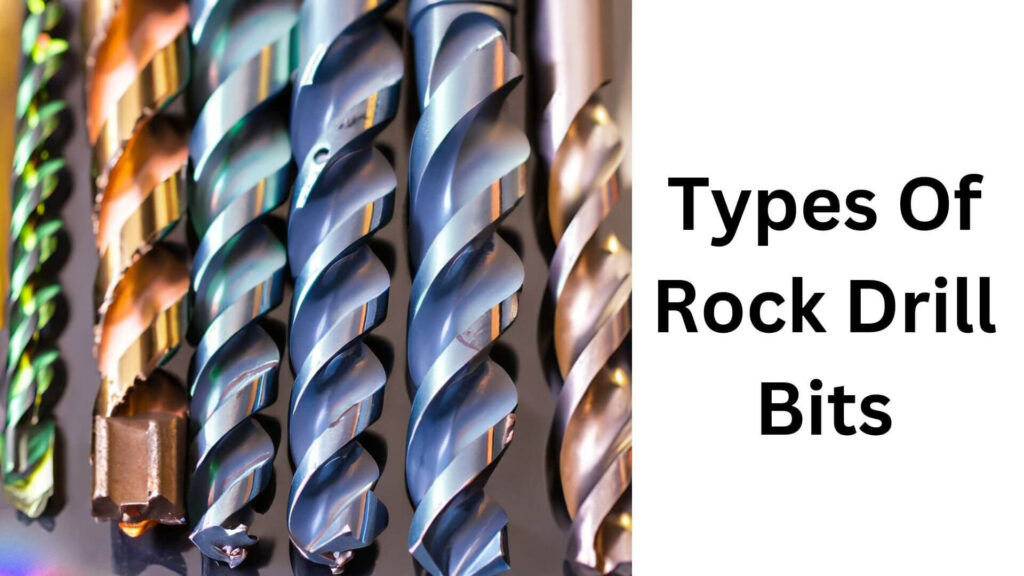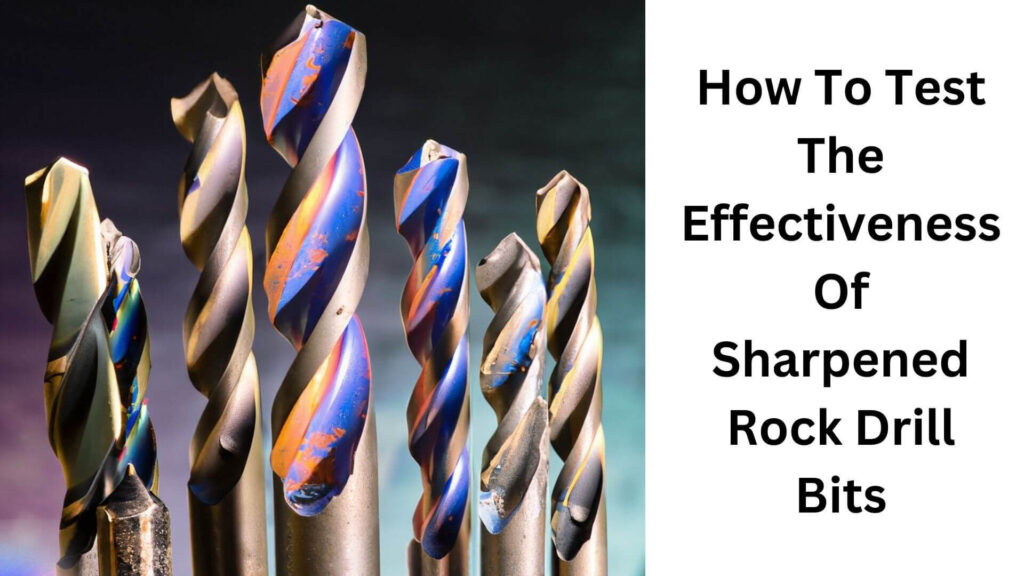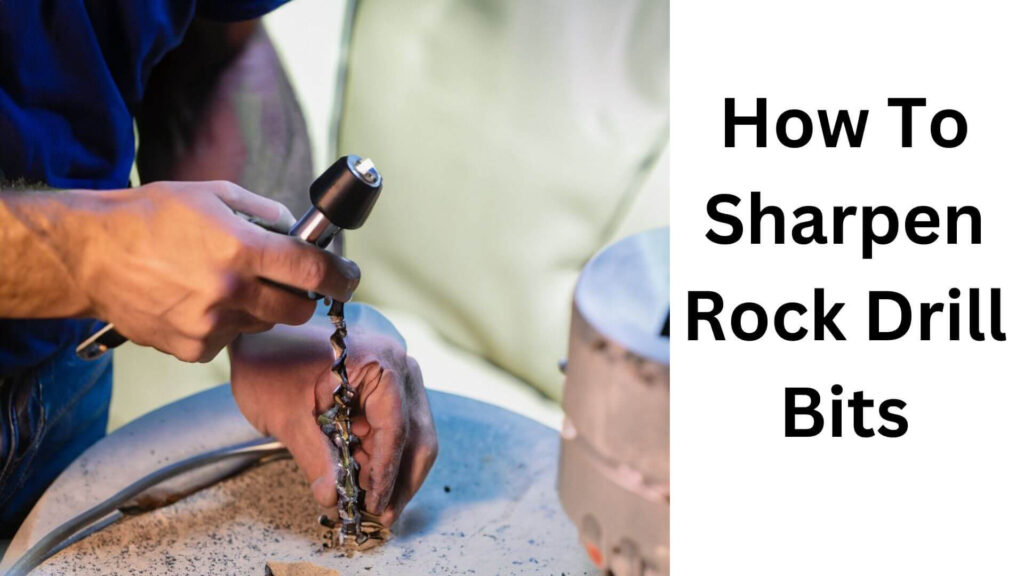Are you tired of using dull rock drill bits? Do you want to improve the performance and longevity of your drill bits? Look no further than learning how to sharpen rock drill bits!
But many Drill enthusiasts need to learn how to sharpen rock drill bits? Fret not, I have the ultimate solution to rejuvenate your drilling game.
Sharpening rock drill bits requires using a grinding wheel and a sharpening jig. The grinding wheel will sharpen the drill bit’s face, and the jig will tilt the bit at a precise angle.
In this article, I’ll guide you through the process, from selecting the right tools to achieving the perfect angle.
Whether you’re a seasoned professional or a beginner, mastering this skill will help you achieve better results on your next drilling project. So let’s dive in and learn How To Sharpen Rock Drill Bits!
Table of Contents
What are Rock Drill Bits?

Rock drill bits are specialized tools for drilling into hard materials such as rocks, concrete, and masonry. They are commonly used in construction, mining, and geological exploration.
These bits typically consist of a steel body with a tungsten carbide or diamond cutting edge. The cutting edge is responsible for the penetration and removal of the material during drilling.
Rock drill bits come in various shapes and sizes to suit different drilling applications, and they require periodic sharpening to maintain their effectiveness and prolong their lifespan.
Types Of Rock Drill Bits

Rock drill bits are essential for drilling holes in hard rocks, stones, or other materials. Different rocks may need different drill bits to achieve the desired results. There are four types of rock drill bits that are commonly used.
- Tri-cone bits
- Steel tooth bits
- Tungsten carbide inserts
- Diamond bits
Explanation Of How Each Type May Require Specific Sharpening Methods
Each type of rock drill bit may require different sharpening methods to maintain its efficiency and effectiveness.
- Tri-cone bits: Tri-cone bits have three cones attached to the bit’s head and are mainly used in oil and gas drilling. These bits require a specific type of sharpening method involving a grinder with diamond blades and a grinding wheel to sharpen the cones’ teeth.
- Steel tooth bits: Steel tooth bits are the most common rock drill bits with sharp steel teeth that cut through hard rock.
They require sharpening using a rock drill bit sharpener machine to grind the teeth to the correct angle and shape to increase their cutting ability and overall lifespan.
- Tungsten carbide inserts: Tungsten carbide inserts are used in complex rock formations and are attached to the bit using a welding process.
To sharpen the inserts, a grinding wheel is used to grind the inserts to the desired shape and angle to maintain their cutting efficiency.
- Diamond bits: Diamond bits are the most expensive yet effective drill bits in drilling hard rocks. They require specific sharpening methods that involve resetting the diamonds by welding and polishing them diamonds to increase their lifespan and maintain their cutting efficiency.
Therefore, each type of rock drill bit requires distinctive sharpening methods to maintain its effectiveness and prolong its lifespan. Always sharpen your bits regularly to avoid unnecessary expenses and save time during drilling.
Tools Needed For Sharpening Rock Drill Bits
Before sharpening your rock drill bits, you must gather the necessary tools.
- A bench grinder: This tool will help you grind the bits to the desired shape and sharpness.
- A jig or gauge: This tool will ensure the bits are sharpened at the correct angle. You can purchase a jig or gauge online or at your local hardware store.
- Safety gear: Wear safety glasses and gloves to protect yourself from flying debris during the sharpening process.
Safety Precautions To Take Before Sharpening
While sharpening your rock drill bits, safety should be your top priority.
- Ensure that the bench grinder is stable and well-positioned.
- Test the wheel for cracks or damages before turning on the bench grinder. Damaged wheels can easily break during operation and cause severe damage.
- Securely clamp the bits before sharpening them to prevent them from moving around.
- Wear the appropriate safety gear, including safety glasses to protect your eyes from any flying debris and gloves to keep your hands safe from sharp bits.
Remember, if you need help with how to sharpen your rock drill bits correctly, consider consulting a professional.
Step-By-Step Guide To Sharpening Rock Drill Bits
Rock drilling is a complex and demanding task that requires excellent tools to perform correctly. In particular, rock drill bits require considerable upkeep and maintenance to keep their effectiveness.
Sharpening rock drill bits is necessary to ensure they operate at their full potential. I will discuss the different methods for sharpening drill bits and the step-by-step guide to make it happen.
To sharpen a rock drill bit, follow some standard procedures to ensure the process runs smoothly and safely.
Step 1: Clean the drill bit.
Ensure the drill bit is clean and free of debris. Any dirt or rocks present underneath the drill’s flutes could cause the bit to bind, leading to improper sharpening.
Step 2: Assess the drill bit.
Look at the drill bit and determine its number of lips or edges. A standard rock drill bit usually has two lips, but some may have three; a higher amount may have more. You must assess the number of edges present before proceeding.
Step 3: Place the drill bit into the jig.
A drill bit jig is necessary to keep the bit stationary while sharpening. Place the jig onto the grinding wheel and adjust the drill bit’s angle according to the bit’s lip angle.
Step 4: Begin the sharpening process.
Start the grinding wheel and slowly bring the drill bit toward it until it contacts the grindstone. Continue sharpening until the grinding wheel removes enough material to point the lip correctly.
Step 5: Alternate sides.
Sharpen one lip, then a short lip on the other side, then back to the first lip and so on. Ensuring they are sharpened evenly and giving extra attention to issues such as flat spots that might require attention.
Step 6: Use the marker.
After tightening your jig’s grips and beginning to sharpen the bit, it’s essential to always use a marker on the drill bit’s lip’s web. The marker will indicate the contact point.
Step 7: Cool the bit and jig.
Remove the bit from the jig and cool it thoroughly. This process is critical if your drill bit is made of high-speed steel to keep the steel from overheating, which can damage the bit.
Step 8: Test the bit.
Once the sharpening process is complete, clean the bit using a cloth. Now, test the drill bit by using it on a metal sheet to see the improvement.
Read More: How To Sharpen A Drill Bit With A File – The Easiest Way
Different Sharpening Techniques For Drilling Through Different Types Of Rock
- Soft rock: For this type of rock, bits with a higher cone angle and fewer carbides are more effective. In drilling soft rock, the angle between the bit’s chisel and the bottom of the hole can be much larger than with hard rock.
Therefore, the chisel’s angle must be sharper, ensuring a smooth, round hole with little deviation from the intended path.
- Medium rock: Medium rock bits require a higher concentration of carbides and a steeper cone angle. A higher number of shorter carbides work best for bits used in medium rock.
These shorter carbides are best for bits used in medium rock because they facilitate a more effortless rock penetration.
- Hard rock: Hard rock bits should have a lower cone angle and a significant concentration of carbides. Hard rock drilling requires greater attention to carbides because the rocks are naturally more complex and more abrasive than their medium or soft counterparts.
Bits used in hard rock require a higher number of more extended carbides to help penetrate the more rigid surface.
Sharpening rock drill bits is crucial, and it’s worth emphasizing that not doing it correctly can lead to ineffective drilling that can be dangerous. Follow the steps outlined above to make your sharpening procedure as effective and easy as possible.
Knowing how to sharpen drill bits might make a big difference in how well your equipment performs and ultimately leads to better and more accurate drilling with less downtime and fewer equipment failures.
Read More: What is a Split Point Drill Bit & How it Works?
How To Test The Effectiveness Of Sharpened Rock Drill Bits

If you are a rock drill operator, you know that a blunt drill bit is a nightmare that leads to inefficiencies, costing you a lot of time and money.
But, by sharpening your rock drill bits, you can improve the efficiency of your drilling operation and cut down on expenses.
However, sharpening is only half the job. You need to test your sharpened rock drill bits to ensure that they are effectively sharpened, and this is what this section will focus on.
Here are a few ways to test the effectiveness of newly sharpened rock drill bits:
● Check for sharpness
by running your fingers across the tip. If the tip feels sharp, that indicates that the sharpening worked.
● Drill a test hole.
Choose a position and drill a test hole with the newly sharpened bit. Assess the time taken to drill the hole and also the overall quality of the hole. A sharpened bit should make a clean and precise hole.
● Hammer test
The easiest test to perform is by taking a hammer and tapping the head of the drill bit. A well-sharpened drill bit should make a clear metallic sound, indicating effective sharpening.
Testing newly sharpened rock drill bits is essential to assess their effectiveness and ensure they perform optimally. By implementing these testing methods, you’ll be able to approbate the effectiveness of your newly sharpened bits before putting them to use.
This will save you time and money and improve your overall efficiency in the long run.
The Dos And Don’ts On How To Sharpen Rock Drill Bits?
| Do’s | Don’ts |
| Gather the necessary tools: safety goggles, gloves, | Rush the sharpening process without proper preparation, |
| and a bench grinder with a fine-grit grinding wheel | Neglect wearing protective gear for your safety. |
| Inspect the rock drill bit for damage or wear. | Sharpen the bit if it’s severely damaged or beyond repair. |
| Clean the bit thoroughly to remove debris. | Sharpen the bit without cleaning it first. |
| Secure the bit firmly in a vice or clamp. | Hold the bit with your hands while sharpening. |
| Use a honing stone to remove minor nicks and burrs. | Use excessive force that may damage the cutting edge. |
| Maintain the original direction of the cutting edge. | Alter the original angle of the cutting edge. |
| Grind the bit evenly and smoothly. | Overheat the bit with excessive grinding or prolonged sessions. |
| Take breaks to prevent overheating. | Neglect breaks, leading to overheating and potential damage. |
| Test the bit’s sharpness by lightly touching it. | Test the bit’s sharpness by touching it with bare fingers |
| against a fingernail or thumbnail. |
Remember, adhering to these do’s and avoiding the don’ts will ensure a safe and effective process when sharpening your rock drill bits, maximizing their performance and longevity.
Tips And Tricks For Maintaining The Sharpness Of Rock Drill Bits Over Time
To maintain the sharpness of rock drill bits over time, you must follow some best practices to optimize your drilling operation.
- Always ensure the quality of the rock drill bits you are using. Low-quality drill bits will wear out faster, making it increasingly challenging to keep them sharp.
- Avoid drilling in areas with a high water-to-rock ratio, as it causes rocks to soften and wear out the drill bits quickly.
- Always check the weight of your drilling machine and ensure that it is optimized; a heavy drill makes it challenging to maintain the bits’ sharpness over time.
- When operating your drilling machine, ensure that all the parts are well lubricated, as it reduces the resistance and provides a smoother drilling experience.
- After every drill, take some time to clean the bits with a brush and compressed air to remove accumulated rocks and prevent rust formation.
Explanation Of Regular Maintenance Practices
As mentioned earlier, maintaining rock drill bits is critical to the success of your drilling operations.
- Regular cleaning – removing the accumulated debris from the drill bits is essential. Use water and the right type of brush to clean the bits thoroughly.
- Check for wear and tear – examine the bits carefully for any signs of wear or tear. Replace any bits that are beyond repair.
- Sharpen the bits – you can either use specialized grinding tools or take them to a professional to get it done.
- Proper storage – always store the bits appropriately, dry and rust-free.
Keeping your rock drill bits sharp is crucial to your drilling operation’s success. Follow the tips and tricks we have shared, maintain your drill bits regularly, and you’ll ensure that they function correctly over extended periods, maximizing your drilling efficiency.
Frequently Asked Questions Of How To Sharpen Rock Drill Bits?
How Do You Know When A Rock Drill Bit Needs Sharpening?
If a rock drill bit no longer cuts efficiently, it could be dull and needs sharpening.
What Is The Best Way To Sharpen A Rock Drill Bit?
Use a good quality bench grinder, but a drill attachment is ideal for fieldwork.
How Often Should You Sharpen Rock Drill Bits?
It depends on how frequently you use them. Generally, once a month is recommended.
Does The Type Of Rock Affect Drill Bit Sharpness?
Yes, harder rocks like granites wear down the edge of the bit faster than softer rocks.
Can Rock Drill Bits Become Too Sharp?
Over-sharpening can lead to brittle tips and decrease the bit’s lifespan.
In Summary,
Properly sharpened rock drill bits can help you save time and money when drilling. Following the right steps to sharpen them is important to ensure they work efficiently.
Whether working in a quarry, mining site or construction project, knowing how to sharpen your rock drill bits can make all the difference in the world.
Remember to wear protective gear when sharpening your drill bits. To sharpen them effectively, clean the bits, secure them, select the right grinder and grind them, and sharpen the carbide buttons. Following these steps can extend the life of the drill bits and prevent costly replacements.
Sharpening rock drill bits is a crucial skill every expert in quarrying, mining, and construction must have. Take the time to sharpen your rock drill bits properly and reap the benefits of efficiency and long-lasting use.

Hey, I am Shihab Uddin, I’m a huge fan of DIY crafts. My workshop is where I spend most of my spare time, and I’m always working on some project. To that end, I’d like to share some of my knowledge and experience with you in power tools, woodworking, and other specialized materials fabrication.
I will guide you with genuine knowledge that can assist you with deciding whether a drill is appropriate according to your requirements or not. If you want to find the best drill and know which type of drill is most suited for your needs, then I can guide you with my expertise. My passion lies in helping others find the correct products they need at an affordable price.


